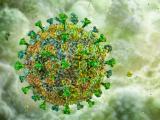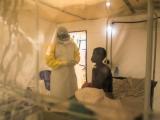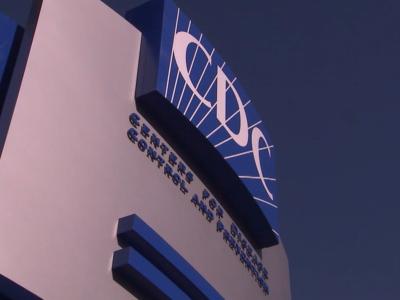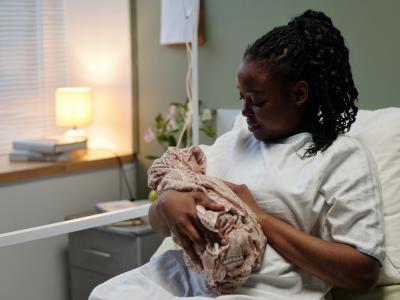Dec 13, 2012 (CIDRAP News) – With tougher security requirements set to take effect next April, few state public health laboratories plan to maintain stocks of certain pathogens considered most tempting to bioterrorists, according to the Association of Public Health Laboratories (APHL) and officials with state labs.
Pathogens such as Bacillus anthracis, Ebola virus, and several others have been designated "Tier 1" agents on the Department of Health and Human Services' (HHS's) list of select agents and toxins. Come Apr 3, labs that want to keep samples of Tier 1 agents on hand will have to meet special rules for personnel screening and physical security, on top of those already required by the Select Agent Program.
Some lab directors describe the extra requirements as burdensome.
A recent informal survey by the APHL suggested that only a few labs will take the trouble to register as Tier 1 labs, said Chris N. Mangal, MPH, the association's director of public health preparedness and response.
"We did a quick survey, and what we've seen so far is only about six of our labs indicated they'd have an interest in pursuing Tier 1 registration," Mangal told CIDRAP News. She said all six were state labs.
Labs participating in the HHS Select Agent Program were supposed to notify the agency last week whether they planned to seek Tier 1 registration. If they don't go that route, they will have to get rid of their Tier 1 samples by April.
Mangal and some other lab experts say that with only a few labs holding Tier 1 registration, the nation's lab capacity could fall short in the event of another bioterrorist incident like the anthrax letter attacks of 2001. Others, though, are less concerned.
Labs not registered to handle Tier 1 agents will still be able to test for and detect them, with the help of control strains that are not dangerous, Mangal and others said. But if they find one of the agents, they will have only 7 days to either destroy the sample or ship it to a lab with Tier 1 credentials.
The 7-day deadline means those labs will have difficulty doing further analysis of Tier 1 agents, such as DNA fingerprinting, which would probably be required if deliberate release of an agent was suspected.
"I don't believe that the Tier 1 select agent requirements will limit their [labs'] ability to perform the initial testing for threat agents," said Mangal. "Where this new regulation becomes a problem is the additional characterization that is typically needed for evidentiary purposes."
Besides Ebola virus and B anthracis, which causes anthrax, Tier 1 agents are Francisella tularensis (the cause of tularemia), Marburg virus, variola major and minor viruses (smallpox), Yersinia pestis (plague), Clostridium botulinum and botulinum toxin (botulism), Burkholderia mallei (glanders), and Burkholderia pseudomallei (melioidosis).
Mangal said that during the 2001 anthrax episode, the Laboratory Response Network (LRN), which then included about 60 labs, ran more 1 million tests. She wonders if, in the event of a similar emergency, the burden of testing would fall mostly on the Centers for Disease Control and Prevention (CDC) in Atlanta and the Department of Homeland Security's National Biodefense Forensic Analysis Center in Maryland.
"Back in 2001 we saw how many samples came through and the vast amount of surge and storage space required," she said. "What would happen if something like that happened again? . . . A surge in samples could possibly overwhelm the limited labs that would be at Tier 1."
The LRN for Biological Threat Preparedness and Response, which now includes about 165 labs, is designated by the CDC and APHL to respond to potential bioterrorism events and other infectious disease threats. Mangal said the APHL worked successfully to ensure that LRN members would not have to qualify for Tier 1 in order to stay in the network.
There have been indications that HHS and the US Department of Agriculture, which administers a separate Select Agent Program, might suspend some of the Tier 1 rules in an emergency, allowing labs to keep agents longer, according to Mangal.
CDC spokesman Jason McDonald agreed that that could happen. He said the federal Bioterrorism Act allows the HHS secretary to exempt a facility from the Select Agent Program regulations if the step is judged necessary because of a public health emergency.
Rules resented
One state lab official who resents the new Tier 1 rules is Joanne Bartkus, PhD, director of the Minnesota Department of Health's (MDH's) Public Health Laboratory in St. Paul.
Bartkus said her lab plans to seek Tier 1 registration. "We felt it was important to maintain the capability to work with these agents," she said. "We felt that keeping the bugs for a week is not really long enough. If we don't maintain that capability, it's gone, possibly forever. So we've been assessing the regulations, and we have a project plan in place to fill any gaps. We feel it's doable."
Referring to the Tier 1 agents, Bartkus said, "These are all naturally occurring diseases that we have to deal with from a public health perspective."
As an example of the kind of problems the new rules might cause, she sketched a hypothetical scenario: Someone in Fargo, N.D., gets sick with anthrax. A week after identifying B anthracis, the North Dakota lab, following the rules, destroys the isolate. Then an anthrax case crops up in Moorhead, Minn., just across the border. With North Dakota's isolate destroyed, there's no way to tell if the cases are linked.
Bartkus concurred with Mangal that labs need more than a week to do specialized analysis of biological agents. Besides DNA fingerprinting, such work can include steps like antimicrobial susceptibility testing and, in the case of botulism, mouse bioassays to identify the type of botulinum toxin.
She believes that forcing labs to get rid of their samples of Tier 1 agents will ultimately diminish their capabilities.
"We'll still have capability and capacity, but to take away the ability to work on agents that are historical isolates because somebody has decided they can be used for bioterrorism" is questionable, she said.
"I think it makes much more sense to treat everything the same way, than to focus on a few agents that I have heard someone refer to as 'your grandfather's bioterrorism agent.'"
Bartkus called the requirement to transfer or destroy Tier 1 agent samples "a fairly onerous, burdensome, and probably unwarranted regulation. And I'm a regulator."
Who needs Tier 1 registration?
David A. Butcher, MBA, director of the Laboratory Services Division of the Colorado Department of Public Health and Environment, has quite a different view of the Tier 1 rules. His lab will not seek registration to hold Tier 1 agents.
"I don't think it's necessary to be a Tier 1 lab," he said. "You don't need to store these agents in your lab. Under the rule you have 7 days to confirm them or transfer or destroy them, and that's easily accomplished in 7 days. You don't really need a repository of those organisms unless you're a research facility."
"I don't feel this in any diminishes our capability," he said. He added that the CDC provides surrogate organisms that are not select agents but mimic them and can be used in testing.
Butcher is president-elect of the APHL, but said he was speaking only for himself.
"I haven't heard anyone clearly articulate why they think we do need them [Tier 1 agents]," Butcher said. "I guess they think they need to periodically test against the real organism. Here in Colorado, Yersinia pestis is endemic, so we see it all the time. We occasionally see Burkholderia; we occasionally see Brucella."
He agreed, however, that the 7-day deadline would hamper advanced analysis of agents.
Burtcher said the Select Agent Program is "very burdensome" for state labs, and the Tier 1 rules make it even more so.
"The biggest burden with Tier 1, and why everyone is upset, is that rule on personnel reliability," he said. "You have to have a program in place to qualify and do an ongoing assessment of people, essentially their mental capacity. Would they have a propensity to do something illegal involving select agents?"
He blames the requirement on the 2001 anthrax attacks and the government's finding that scientist Bruce Ivins, PhD, was the perpetrator.
Butcher voiced doubt that the personnel reliability program required with the Tier 1 rules would be approved by Colorado's human resources department. "I definitely wouldn't be able to get it in place by the Apr 3 deadline," he added.
His lab got rid of its Tier 1 agent samples last April, as part of its response to the last inspection by the Select Agent Program, he said. The decision was prompted by the need to reduce the lab's regulatory burden. "I've been an outspoken advocate of not keeping the agents," he added.
North Carolina also opts out
Another state that will not seek Tier 1 credentials for its public health labs is North Carolina.
"We've decided, based on the changes in the rules, not to pursue Tier 1 status at this time," said Lou Turner, DrPH, acting public health laboratory director for the state. North Carolina operates one central lab and two regional labs, she noted.
The reason for the decision is the "onerous" requirements for personnel reliability and physical security and the resulting costs, she said. A new state lab is about to open, and it would need retrofitting to meet the physical security standards.
Turner doesn't think the lack of Tier 1 registration will hurt the labs' capabilities. "Our critical point was making sure we'd be able to serve our usual partner groups such as the FBI," she said. "They've told us it was not necessary to be a Tier 1 lab. They would still use the state labs as long as they're still select agent labs.
"We'll still be able to identify the agents. If we do, we have to refer them to a Tier 1 lab and destroy any materials. We're perfectly confident of our ability to do that."
Turner said she's not concerned about a decrease in lab capabilities nationwide as a result of the new rules. But she does wonder if states that don't have Tier 1 status will eventually receive less CDC lab support through the public health emergency preparedness program.
She said there are no signs of such a change, but said, "You never know what the mindset would be later, once these decisions are made and they see the landscape of who is where."
Minnesota's Bartkus expressed less concern about the extra requirements for Tier 1 labs, compared with Butcher and Turner. She said Minnesota's lab already meets the physical security requirements, and she doesn't believe the personnel reliability rules will be a major problem.
"One thing a little more vexing is the Internet or IT [information technology] requirements," she said. The CDC wants certain IT resources protected, and MDH officials are still assessing that.
Bartkus said there is some concern about the related costs and the MDH's ability to meet the standards by April. She said she was hoping that the CDC would promise additional funds for labs that achieve Tier 1 status, which she said is the case for Level 1 labs in the LRN for Chemical Threats.
"Those that decide to maintain Tier 1 are pretty much on their own," she said.
See also:
Oct 10 CIDRAP News story "Changes in select agent rules concern public health labs"



















